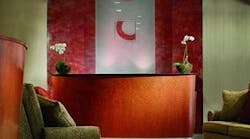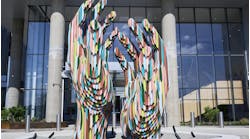The hotel lobby is no longer a transient waiting room between the front door and the guestroom. Formerly a pit stop on the way to the guestroom, the lobby has changed in function, aesthetic, and program. It has become the epicenter of a hotel, where you can hold a quick meeting, grab a drink and a bite to eat, or gather in a casual social setting. To accommodate this trend, hotel chains across the industry are incorporating the concept of multi-functional schemes into their lobby designs.
This new direction of multi-function and flexibility is derived directly from the needs and wants of guests and the community. People today are savvier in their hotel selection, and they're no longer looking for the cheapest rooms. They are looking for the "experience." As part of this experience, people want the lobby to be a place to socialize, work, and relax - all in a warm and inviting atmosphere.
Major hotel brands are already implementing these changes in their properties, and owners are reaping the rewards. Sheraton has introduced the "Link @ Sheraton" into its properties, which is a place for people to stay connected, but in a setting that is closer to a lounge than an enclosed business center. Hampton Inn by Hilton has created its "Perfect Mix Lobby," which features fresh, contemporary finishes; communal tables; and the ability to close off the buffet area in order to transform the space into a casual gathering area after breakfast hours.
Marriott is reinventing its full-service lobbies by creating multiple zones - such as Relaxing, Individual, and Business - all within the same lobby space. Courtyard by Marriott has also unveiled its new lobby scheme, which creates a welcoming space with flexible seating, private media centers, an intimate lounge area, and communal spaces. In addition to promoting social interaction, it has replaced the traditional front desk with welcome podiums that encourage guests to establish personal connections while interacting with their host.
Each of these lobby ideas allows the individual to create his/her own experience, but the hotel must provide the tools that allow this to happen. It's no secret that this is a major shift in the hotel industry, and designers are charged with the task of creating these new, engaging spaces. Although this move to get the guests out of their rooms and bring local traffic into the lobby and lounge area has a revenue component, the social aspects that lend vitality to the space are much more compelling.
Three recently completed projects that exemplify this new lobby direction are the Sheraton Colonial Boston North Hotel & Conference Center in Wakefield, MA; the Onyx Hotel in Boston; and the Courtyard by Marriott in Cambridge, MA.
The Sheraton Colonial Hotel, as it used to exist, contained a disjointed mixture of guestrooms, offices, and conference space. In addition to converting the offices into a conference center that meets the requirements of the Intl. Association of Conference Centers, the charge was to connect these spaces through a cohesive design by creating flexible seating areas and diverse zones for guest interaction. One of the largest changes to this property was the addition of the "Link @ Sheraton" component. It was constructed in an area adjacent to the lobby, restaurant, and meeting facilities for people to gather, check e-mail, or enjoy conversation over coffee. This location provided the perfect opportunity to bring these services together to create the multi-functional Technology Lounge for guests, which has been extremely successful since its implementation. The hotel always had a steady flow of outside traffic to its restaurant, but it has increased in the lobby and gathering spaces as well.
At the Onyx Hotel, the challenge was to design a compact and efficient lobby. Located in the historic Bulfinch Triangle, just one block from the Boston Garden, with continual foot traffic right outside, this lobby needed to be an integral part of the neighborhood. In addition to functionality, the lobby also needed to create a lounge experience that would draw in passersby and appeal to the hotel's guests. The lobby itself is part of the lounge, separated by a banquette-seating wall that serves as the backdrop for a signature seating element with vibrant colors and pillow accents. Meanwhile, on the other side of this furniture wall, a luxurious lounge bar provides intimate areas to enjoy a martini and appetizer before heading out for the night. The day lounge is full of people with laptops, utilizing the high-speed wireless Internet and getting caught up on their work. During the day, the bright lighting is more conducive to business; in the evening, a softer glow creates a warm, social ambiance. The flexibility of these spaces allows the lobby to transform its function to suit all of the guests' needs.
Originally a Radisson, the Courtyard by Marriott is a renovation located on Memorial Drive in Cambridge, MA. Limited space on the first floor shaped the lobby into a multi-level core, tied together by a central, monumental staircase. A series of bright pendant lights, suspended from delicate wires, spirals through a three-story atrium, illuminating the elegant, open stairway. The lowest level opens onto a vibrant seating arrangement and an intimate concierge desk, set off to one side with the Market. Quiet gathering areas surround the stairway, which leads up to the more collective functions. On the mid level, a sweeping restaurant, lounge, and bar create a lively social atmosphere. The business library, sheltered to one side, provides an area for travelers to get some work done. The third floor tops the lobby with a formal ballroom and a private meeting room. The guestrooms that surround one corner of the second and third floors, set off by a private corridor, bring the guests ever closer to these engaging communal spaces.
As hotels continue to focus on the "experience," drawing the guests out of their rooms and into a social community, it's even more important to understand the impact of the lobby. A successful property is no longer the one that simply provides good service and clean rooms. The lobby area is now the place to bring a client, the place to see and be seen. It's the neighborhood lounge and favorite hotspot - the place that people feel proud to call part of their community.
Harry Wheeler is principal at Boston-based Group One Partners.


